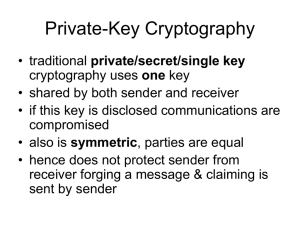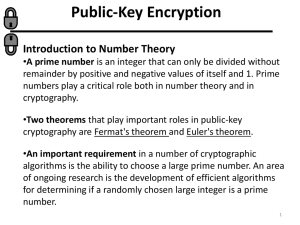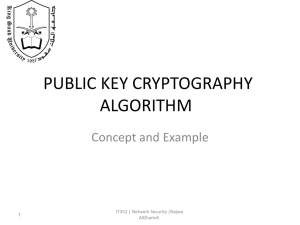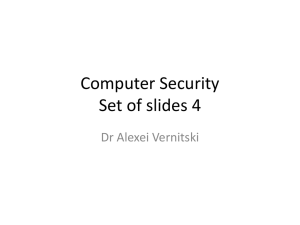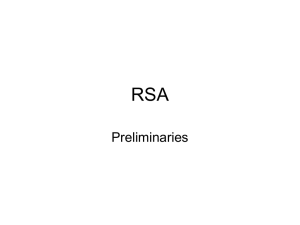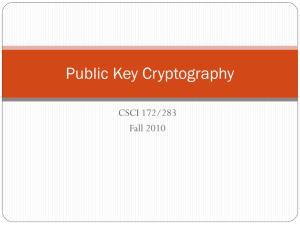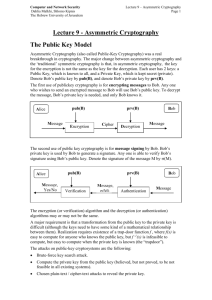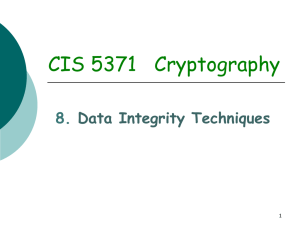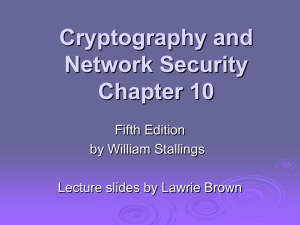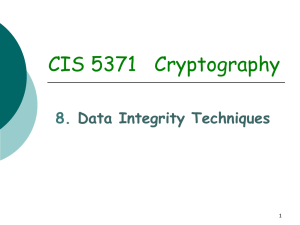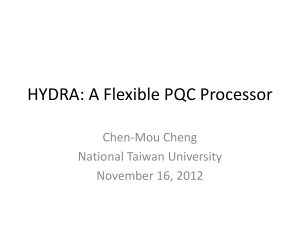ppt - IT352 : Network Security
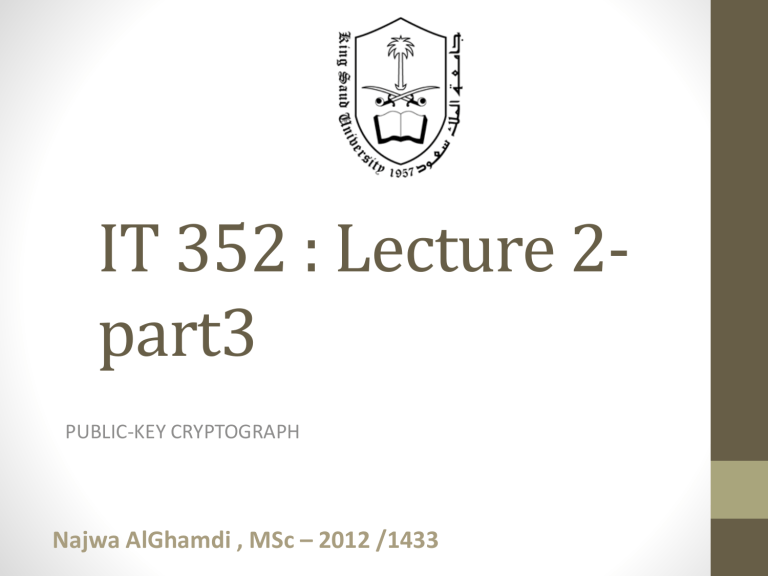
IT 352 : Lecture 2part3
PUBLIC-KEY CRYPTOGRAPH
Najwa AlGhamdi , MSc – 2012 /1433
Outline
• Public Key Cryptography
• Public Key Cryptography Algorithms.
• Key Exchange Protocols
• Digital Signature.
Public Key Cryptography
• probably most significant advance in the 3000 year history of cryptography
• uses two keys – a public & a private key
• asymmetric since parties are not equal
• uses clever application of number theoretic concepts to function
• complements rather than replaces private key crypto
Public Key Cryptography
• developed to address two key issues:
• Encryption/decryption : The sender encrypts a message with recipient’s public key.
• key distribution – how to have secure communications in general without having to trust a KDC with your key
• digital signatures – how to verify a message comes intact from the claimed sender
• public invention due to Whitfield Diffie & Martin Hellman at
Stanford Uni in 1976
• known earlier in classified community
• Example of public key cryptography algorithms : RSA, Diffe-
Hellman, DSS and elliptic curve.
Public Key Cryptography
• public-key/two-key/asymmetric cryptography involves the use of two keys:
• a public-key, which may be known by anybody, and can be used to encrypt messages, and verify signatures
• a related private-key, known only to the recipient, used to decrypt messages, and sign (create) signatures
• infeasible to determine private key from public
• is asymmetric because
• those who encrypt messages or verify signatures
cannot decrypt messages or create signatures
Application for public Key cryptosystem
Public Key Cryptography
Symmetric vs Public-Key
PUBLIC KEY CRYPTOGRAPHY
ALGORITHM
1.RSA
2.DIFFE-HELLMAN
RSA
by Rivest, Shamir & Adleman of MIT in 1977
best known & widely used public-key scheme
based on exponentiation in a finite (Galois) field over integers modulo a prime
nb. exponentiation takes O((log n) 3 ) operations (easy)
uses large integers (eg. 1024 bits)
security due to cost of factoring large numbers
nb. factorization takes O(e log n log log n ) operations (hard)
RSA En/decryption
• to encrypt a message M the sender:
• obtains public key of recipient PU={e,n}
• computes: C = M e mod n , where 0≤M<n
• to decrypt the ciphertext C the owner:
• uses their private key PR={d,n}
• computes: M = C d mod n
• note that the message M must be smaller than the modulus n
(block if needed)
RSA Key Setup
• each user generates a public/private key pair by:
• selecting two large primes at random: p, q
• computing their system modulus n=p.q
• note ø(n)=(p-1)(q-1)
• selecting at random the encryption key e
• where 1<e<ø(n), gcd(e,ø(n))=1
• solve following equation to find decryption key d
• e.d=1 mod ø(n) and 0≤d≤n
• publish their public encryption key: PU={e,n}
• keep secret private decryption key: PR={d,n}
Why RSA Works
• because of Euler's Theorem:
• a ø(n) mod n = 1 where gcd(a,n)=1
• in RSA have:
• n=p.q
• ø(n)=(p-1)(q-1)
• carefully chose e & d to be inverses mod ø(n)
• hence e.d=1+k.ø(n) for some k
• hence :
C d = M e.d
= M 1+k.ø(n) = M 1 .(M ø(n) ) k
= M 1 .(1) k = M 1 = M mod n
RSA Example - Key Setup
1.
Select primes: p =17 & q =11
2.
Calculate n = pq =17 x 11=187
3.
Calculate ø( n )=( p– 1)( q1)=16x10=160
4.
Select e : gcd(e,160)=1; choose e =7
5.
Determine d : de= 1 mod 160 and d < 160 Value is d=23 since 23x7=161= 10x160+1
6.
Publish public key PU={7,187}
7.
Keep secret private key PR={23,187}
RSA Example - En/Decryption
sample RSA encryption/decryption is:
given message M = 88 (nb.
88<187 )
encryption:
C = 88 7 mod 187 = 11
decryption:
M = 11 23 mod 187 = 88
2.Diffie-Hellman Key Exchange
• first public-key type scheme proposed
• by Diffie & Hellman in 1976 along with the exposition of public key concepts
• note: now know that Williamson (UK CESG) secretly proposed the concept in 1970
• is a practical method for public exchange of a secret key
• used in a number of commercial products
Diffie-Hellman Key Exchange
• a public-key distribution scheme
• cannot be used to exchange an arbitrary message
• rather it can establish a common key
• known only to the two participants
• value of key depends on the participants (and their private and public key information)
• based on exponentiation in a finite (Galois) field
(modulo a prime or a polynomial) - easy
• security relies on the difficulty of computing discrete logarithms (similar to factoring) – hard
Diffie-Hellman Setup
• all users agree on global parameters:
• large prime integer or polynomial q
• a being a primitive root mod q
• each user (eg. A) generates their key
•
• chooses a secret key (number): x
A compute their public key: y
A
< q
= a xA mod q
• each user makes public that key y
A
Diffie-Hellman Key Exchange
• shared session key for users A & B is K
K
AB
= y
A
= y
B
= a xA.xB
xB xA mod q mod q (which mod q (which
B
A
AB
: can compute) can compute)
• K
AB is used as session key in private-key encryption scheme between Alice and Bob
• if Alice and Bob subsequently communicate, they will have the same key as before, unless they choose new public-keys
• attacker needs an x, must solve discrete log
Diffie-Hellman Example
• users Alice & Bob who wish to swap keys:
• agree on prime q=353 and a=3
• select random secret keys:
• A chooses x
A
=97, B chooses x
B
=233
• compute respective public keys:
• y
A
= 3
97
• y
B
= 3
233 mod 353 = 40 (Alice) mod 353 = 248 (Bob)
• compute shared session key as:
• K
AB
• K
AB
= y
= y
B xA
A xB mod 353 = 248
97 mod 353 = 40
233
= 160 (Alice)
= 160 (Bob)
Key Exchange Protocols
• users could create random private/public D-H keys each time they communicate
• users could create a known private/public D-H key and publish in a directory, then consulted and used to securely communicate with them
• both of these are vulnerable to a meet-in-the-Middle Attack
• authentication of the keys is needed
Man-in-the-Middle Attack
1.
Darth prepares by creating two private / public keys
2.
Alice transmits her public key to Bob
3.
Darth intercepts this and transmits his first public key to Bob.
Darth also calculates a shared key with Alice
4.
Bob receives the public key and calculates the shared key (with
Darth instead of Alice)
5.
Bob transmits his public key to Alice
6.
Darth intercepts this and transmits his second public key to Alice.
Darth calculates a shared key with Bob
7.
Alice receives the key and calculates the shared key (with Darth instead of Bob)
Darth can then intercept, decrypt, re-encrypt, forward all messages between Alice & Bob
Digital Signatures
• have looked at message authentication
• but does not address issues of lack of trust
• digital signatures provide the ability to:
• verify author, date & time of signature
• authenticate message contents
• be verified by third parties to resolve disputes
• hence include authentication function with additional capabilities
Digital Signatures
Digital Signatures Model
Resources
• Network Security Essential , chapter 1 .
